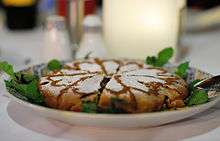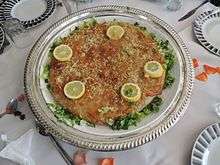Pastilla
Pastilla (Moroccan Arabic: بسطيلة, romanized: basṭīla) is a traditional North African dish in the form of a sweet, savory meat pie or spicy seafood pie with werqa (ورقة), leaves of dough similar to phyllo. It is historically documented to be consumed in Morocco and Algeria where it is called r’zima (رزيمة) or tajik.[1][2] It has more recently been spread by emigrants to France, Israel, and North America.
 | |
| Alternative names | Pastel |
|---|---|
| Type | Meat pie |
| Place of origin | North Africa |
| Region or state | Morocco, Algeria, France, Israel, North America, Tunisia |
| Main ingredients | Warka dough, broth, spices; squab, chicken, fish or offal |
Origin
The name of the pie comes from the Spanish word pastilla, meaning in modern Spanish either "pill" or "small pastry" after the transformation of the phoneme "p" into "b" that is specific to the Arabic language.[3] The researcher Anny Gaul attests to recipes that bear "a strong resemblance to the stuffing that goes inside modern-day bastila" in 13th century Andalusi cookbooks, such as Ibn Razīn al-Tujībī's "Faḍālat al-khiwān fī ṭayyibāt al-ṭaʻām wa-al-alwān" (فضالة الخوان في طيبات الطعام والألوان).[1][4]
The historian Idriss Bouhlila, while acknowledging that Tetuanis consider the dish to be of Andalusi origin, posited that the dish was introduced into Morocco by the Algerians who migrated to Tétouan after the French invasion of Algiers in 1830,[5] corroborating Gaul's theory that its name, which according to Bouhlila is of Turkish origin, and the werqa pastry used to make it spread from Tetuan to the rest of Morocco sometime after 1830.[1][5]
According to the Professor Ken Albala, the basic concept of pastilla was probably brought to Morocco by Moorish Muslims who left Spain in the 16th century, or perhaps earlier, because there had been considerable traffic between Morocco ans Spain since the Moors conquered the latter in the seventh century.[6]
In Morocco, there are two main versions of pastilla: one with poultry and one with seafood.[7] Pastilla is generally served as a starter at the beginning of special meals.[8]
In Algeria, Pastilla is usually made with chicken or with pigeon.[9][10]
Poultry pastilla

Poultry pastilla was traditionally made of squab (fledgling pigeons), but shredded chicken is more often used today. It combines sweet and salty flavours; crisp layers of the crêpe-like werqa dough, savory meat slow-cooked in broth and spices and then shredded, and a crunchy layer of toasted and ground almonds, cinnamon, and sugar.[11] The filling is made by browning the poultry in butter. Chopped onions, water, parsley, and various spices including saffron are added and the meat is simmered until tender. When cool, the meat is boned and the flesh shredded. The liquid is reduced and thickened with eggs to form a custard-like sauce. Meat and custard are often prepared the day ahead.
Blanched almonds are fried in oil, then crushed finely and mixed with powdered sugar and cinnamon. In a round baking pan, several pieces of the thin werqa or filo dough are layered, each brushed with melted butter, and overhanging the edge of the pan. The cook adds the egg mixture, places another buttered sheet of dough over it, adds the shredded meat, also covered with a sheet of dough, and then the almond mixture is added. The overlapping pieces of dough are folded over the filling, and another 2 pieces of buttered dough are added and tucked in around the edges of the pie. The pie is baked until heated through, and the layers of dough are brown. Powdered sugar and cinnamon are sprinkled over the top before serving hot.[12]
Seafood pastilla

Seafood pastilla (Moroccan Arabic: بسطيلة الحوت) usually contains fish and other seafood, in addition to vermicelli. Unlike poultry pastilla, seafood pastilla is not sweet, but spicy.
Whereas poultry pastilla is dusted with powdered sugar and cinnamon, seafood pastilla is usually dressed with a light sprinkle of shredded cheese and a few slices of lemon.
This version of pastilla is often served at Moroccan weddings.[13]
Pastilla with milk

In the traditional Fassi cuisine, pastilla can also be served as a dessert, in which case, the pastilla is called Jowhara (جوهرة, jewel) or "Pastilla with milk". This pastilla is also made of warka and a milky cream put between the sheets. The Jowhara is flavored with orange flower water and decorated with cinnamon and sugar. [14]
Sephardic Jewish version
Among Moroccan Jews, pastilla is made with olive oil or margarine to follow kosher rules.
An increasingly popular variant makes individual pastries rather than large pies.[15]
See also
References
| Wikimedia Commons has media related to Pastilla. |
- Gaul, Anny (2019-11-27). "Bastila and the Archives of Unwritten Things". Maydan. Retrieved 2019-12-13.
I was especially interested in Tetouani baqlawa, a pastry typically associated with the eastern Mediterranean, not the west. The baqlawa we sampled was shaped in a spiral, unlike the diamond-shaped version I was more familiar with from Levantine food. But its texture and flavors––thin buttered layers of crisp papery pastry that crunch around sweet fillings with honeyed nuts––were unmistakable. Instead of the pistachios common in eastern baqlawa, El Mofaddal’s version was topped with toasted slivered almonds. Was baqlawa the vehicle that had introduced phyllo dough to Morocco?
There is a strong argument for the Turkic origin of phyllo pastry, and the technique of shaping buttered layers of it around sweet and nut-based fillings was likely developed in the imperial kitchens of Istanbul.[4] So my next step was to find a likely trajectory that phyllo dough might have taken from Ottoman lands to the kitchens of northern Morocco.
It so happened that one of Dr. Bejjit’s colleagues, historian Idriss Bouhlila, had recently published a book about the migration of Algerians to Tetouan in the nineteenth/thirteenth century. His work explains how waves of Algerians migrated to Tetouan fleeing the violence of the 1830 French invasion. It includes a chapter that traces the influences of Ottoman Algerians on the city’s cultural and social life. Turkish language and culture infused northern Morocco with new words, sartorial items, and consumption habits––including the custom of drinking coffee and a number of foods, especially sweets like baqlawa. While Bouhlila acknowledges that most Tetouanis consider bastila to be Andalusi, he suggests that the word itself is of Turkish origin and arrived with the Algerians."
...
"Bouhlila’s study corroborated the theory that the paper-thin ouarka used to make bastila, as well as the name of the dish itself, were introduced to Morocco by way of Tetouani cuisine sometime after 1830. - "Migrations" (PDF). www.hommes-et-migrations.fr.
- Bastilla. Clifford A Wright. 2016
- Ibn Razīn al-Tuǧībī, ʻAlī b. Muḥammad; Ibn Šaqrūn, Muḥammad (1984). Fuḍālat al-k̲iwān fī ṭayyibāt al-ṭaʻām wa-al-alwān: ṣūra min fann al-ṭabk̲ fī al-Andalus wa-al-Maġrib fī bidāyat ʻaṣr Banī Marīn li-Ibn Razīn al-Tuǧībī (in Arabic). Bayrūt: Dār al-Ġarb al-Islāmī. OCLC 776451991.
- Idriss Bouhlila. الجزائريون في تطوان خلال القرن 13هـ/19م. pp. 128–129.
- Albala, Ken (2011-05-25). Food Cultures of the World Encyclopedia [4 volumes]: [Four Volumes]. ABC-CLIO. ISBN 978-0-313-37627-6.
- Don Philpott (20 October 2016). The World of Wine and Food: A Guide to Varieties, Tastes, History, and Pairings. Rowman & Littlefield Publishers. p. 278. ISBN 978-1-4422-6804-3.
- Fodor's Travel Publications, Inc (2012). Fodor's Morocco. Fodors Travel Publications. pp. 19–. ISBN 978-0-307-92832-0.
- Philip M. Allen; Aaron Segal (1973). The Traveler's Africa: A Guide to the Entire Continent. Hopkinson & Blake, Publishers. p. 83. ISBN 978-0-911974-07-2.
- Ken Albala (2011). Food Cultures of the World Encyclopedia. ABC-CLIO. p. 8. ISBN 978-0-313-37626-9.
- "Pastilla Recipe - Bastilla Recipe - Delicious Techniques". norecipes.com.
- https://www.196flavors.com/morocco-pastilla/
- "في العرس المغربي: صناديق مبتكرة لتقديم الهدايا وطقوس عريقة". مجلة سيدتي (in Arabic). 2016-09-05. Retrieved 2020-02-21.
- "Traditional Moroccan Food | Moroccanzest". Moroccanzest. 2018-07-28. Retrieved 2018-11-05.
- Solomonov, Michael (2016). Zahav: A World of Israeli Cuisine. HMH.
- "Did You Know: Food History - Bastila: a Culinary History of Morocco". www.cliffordawright.com. Archived from the original on 2015-02-20. Retrieved 2017-05-25.
